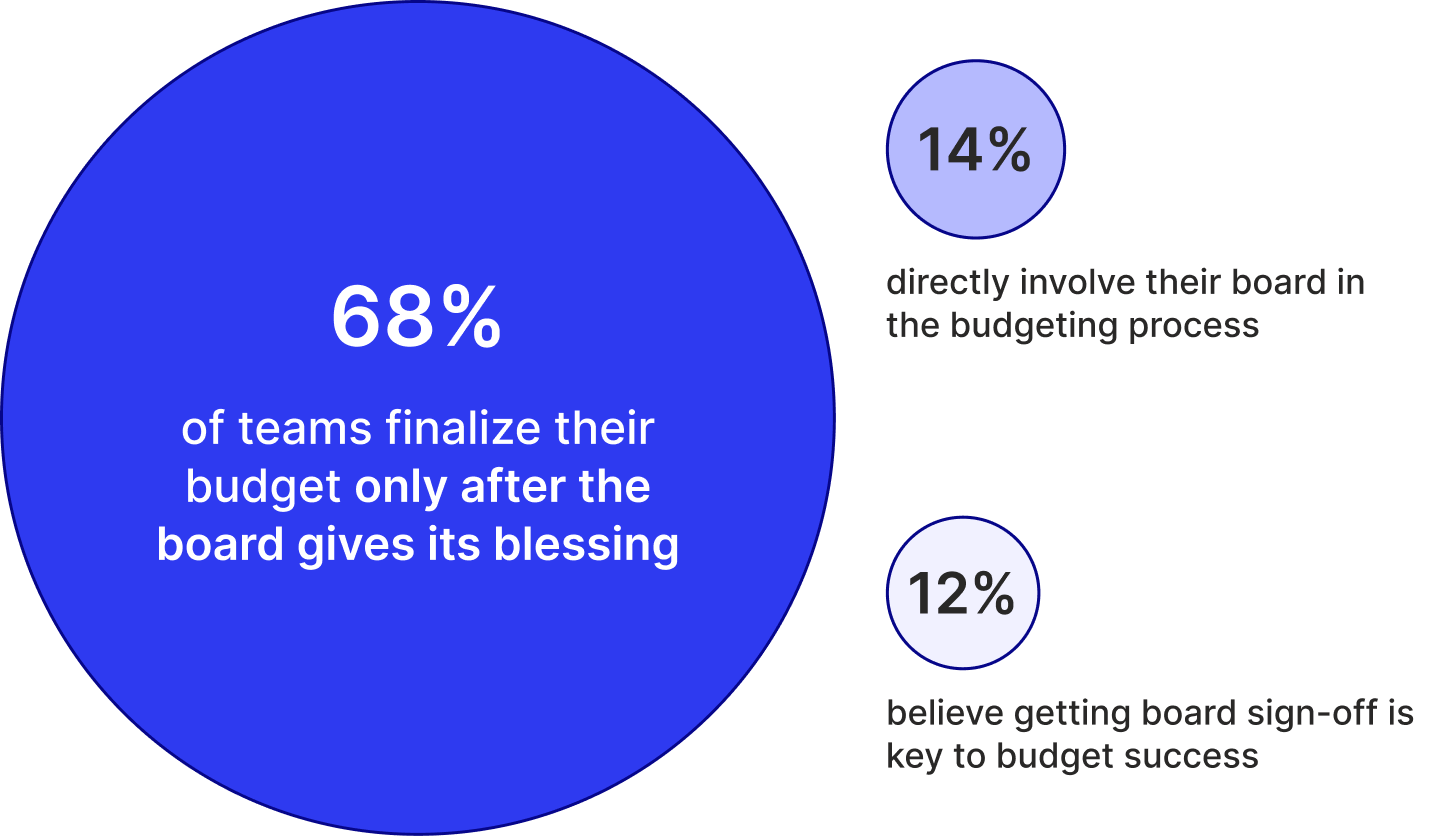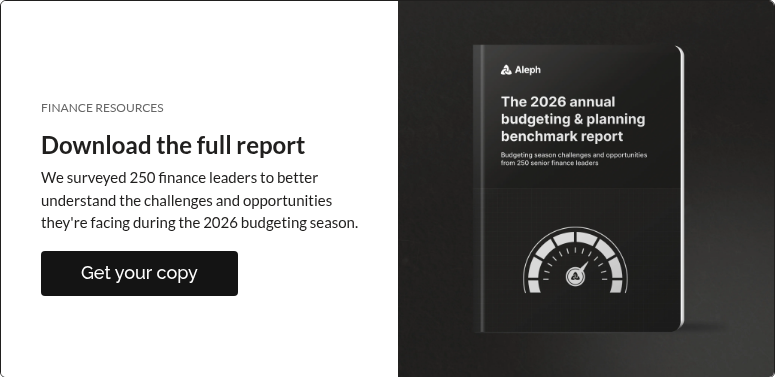Get FP&A best practices, research reports, and more delivered to your inbox.
The hardest part of budgeting isn’t the numbers. It’s the people.
Each stakeholder group has different needs. Finance teams tend to prioritize execs early on, then shift focus to department heads and business partners as inputs evolve.
But one group that often gets looped in way too late is the board of directors. Our budgeting survey found that while 68% of teams finalize their budget only after the board gives its blessing, just 14% actually involve the BOD in the process.

That’s a problem. Not because the board should weigh in on every line item, but because when they see a fully-baked budget for the first time near the finish line, you’re far more likely to get major last-minute changes that derail your timeline.
Leadership, business partners, and the board all need to be managed differently. But what’s universally true is that early, high-level alignment is better for all involved.
In this post, we’ll break down how to time those check-ins so you can keep everyone in the loop without slowing the process down.
Create a loop that actually closes
Align before you assign
As we’ve covered throughout this series, the first step to building alignment is grounding every stakeholder—finance, department leads, execs, and the board—in the same shared reality.
Before anyone touches a template, align on three things:
Revenue, margin, runway, and hiring guardrails
Make clear that these are not final numbers. They’re directional guideposts to keep teams from straying too far from the zone of what’s possible. Without them, your early inputs become irrelevant halfway through.
KPI definitions
Don’t assume everyone’s using the same logic. Codify your shared definitions so nobody reopens old math three weeks in and derails the conversation.
Decision rights
If one team thinks they’re deciding and another thinks they’re just advising, that loop’s going to break. Get clear on who’s driving vs. informing before the back-and-forth begins.
Clear, well-communicated constraints are a necessary ingredient for harnessing iterative feedback without letting it spin out of control.
Plan for three deliberate passes
Per our survey, three formal budget revisions is the sweet spot:

To the 35 respondents that nailed it in one pass…

For the rest of us mortals, three revision rounds is usually what it takes to get alignment without spinning your wheels.
Here’s how we recommend structuring them:
V1: Directional
Start broad. Identify where the big gaps are—what’s missing, what’s unclear, what needs input. Focus on surfacing issues rather than solving them.
V2: Narrowed
Time to make tradeoffs. What are we willing to give up? What assumptions do we need to pressure-test?
V3: Near-final
This is the version you’re ready to recommend. It’s complete enough to invite feedback, but still changeable if necessary.
Many planning loops fail because teams try to solve everything in one go. Spacing the conversation across three focused passes gives stakeholders time to engage meaningfully without losing the thread or steamrolling the ones who weren’t ready to weigh in.
Build shared memory along the way
Moving forward is contingent upon remembering where you’ve been. Lose that thread, and you’ll be stuck rehashing old debates.
The fix is simple: keep a running log from day one.
- Assumption log: what are we basing this on, and who gave us the input? Timestamp it.
- Gap-to-target waterfall: where are we behind? Where are we ahead? What’s closing?
- Decision log: what tradeoffs did we make? What got ruled out?
- Change log: what changed between versions, and why?
These aren’t complicated things to track. But without them, version 4.7 starts to look suspiciously like version 1.3, and before you know it, you’re right back in the same conversation you thought you resolved weeks ago.
Pre-wire the board
Now—as for the big, bad board of directors.
Think about where they’re coming from. They know you’ve been at this for months, but in many cases, they’re seeing the fully-baked plan for the first time. They weren’t privy to the back-and-forth with business partners, the tradeoffs you both painstakingly made.
So while it’s frustrating when your deck comes back bleeding red, it shouldn’t be surprising.
Board meetings shouldn’t be the first time directors hear the story. If they are, you’ve already lost the chance to shape their perspective. Instead, you want to warm the room early.
Here’s how to keep your board in the loop just enough to avoid surprises without slowing anyone down.
1. Set the stage with a five-line summary
Don’t bury the lede. Before diving into your slides, start with a quick snapshot of the plan:
- Targets
- Capital plan
- Hiring stance
- Recommended scenario
This sets the tone and earns you the right to walk through the details. You can also include a simple “risks and opportunities” line to help calibrate how much upside or downside is in play.
2. Send a focused pre-read 72 hours out
Board members should walk into every BOD meeting up to speed and ready to engage with their counterparts. A pre-read gives them space to think and absorb the story on their own terms.
Here’s what to include:
- A one-pager with macro context, KPI definitions, and topline targets
- Three core slides:
- Gap-to-target waterfall with owners
- Scenario matrix (max of 3) with clear triggers and pre-agreed actions
- Resource map tying headcount and dollars to strategy
- A brief summary of your recommendation: what it is, why it works, and how it holds up
Keep it tight and save the color commentary for the meeting.
3. Meet ahead of time
Some directors will have questions after reviewing the pre-read. It’s in both of your best interests to address those questions before the meeting.
Set up 1:1s or small-group check-ins with a few key board members one to two weeks out. Walk them through the logic, flag any concerns, and close out open debates before you’re all in the room.
It makes the meeting faster, the feedback sharper, and the board feel like a strategic partner—not a last-minute editor.
4. Build a packet that drives the “yes”
Most directors will skim 80% of your deck, if that. Make sure the 20% that actually drives their decision is rock-solid.
Those three slides above are your backbone. Everything else should support them, not compete for attention.
Keep the appendix light but useful:
- A one-pager of KPI definitions
- A snapshot of major risks and mitigations
- A model hygiene note (last refresh, version, known limitations)
Your goal for this packet is to make it easy for them to greenlight the plan with confidence.
5. Stick the landing
Once you get the thumbs-up, don’t lose momentum. End the meeting by clearly stating:
- What’s been approved
- What assumptions you’ll be watching
- When the next re-forecast will happen
BOD approval is an important checkpoint, but that doesn’t mean it’s time for a victory lap. Wrap with clarity so nobody’s caught off guard when it’s time to revisit the plan.
Manage up to the board level
Boards don’t want to torpedo your plan at the 11th hour, but they will if you give them no other choice. Make it easier for them to say yes by looping them into the big-picture tradeoffs early. This way, when it’s time to decide, the hard conversations are already behind you.
In our next (and final) installment of this series, we’ll cover all things tooling: where spreadsheets still hold up, where they fall short, and how the best teams modernize their process without losing what works.
Get FP&A best practices, research reports, and more delivered to your inbox.


.png)









